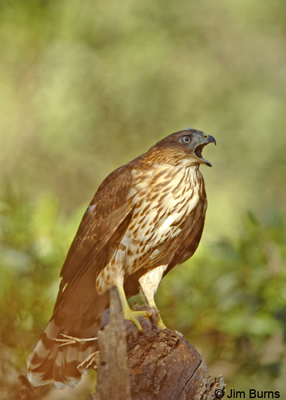
Wending my way upstream, I follow the river through a wonderful remnant of Arizona’s decimated cottonwood forests, dodging the obvious and ubiquitous signs of one of the main culprits of their demise. It’s been said that only ten percent of those riparian woodlands still remain, cattle largely to blame. I spook a committee of Turkey Vultures from their overnight roost (yes, “committee” of vultures like “murder” of crows), and Yellow Warblers sing from the trees every hundred yards.
The Hassayampa here runs fairly straight north/south except when it doesn’t, curling around an occasional high cliff face and the intersecting dry arroyos that feed it during the monsoon torrents of late summer and the all-day soakers of wintertime Pacific fronts. Mesquite fills in the blanks where the cottonwoods have disappeared. A Gray Hawk screams and takes flight as I pass beneath its nest. A Black Phoebe flutter follows some insect prey before disappearing around a bend. It is only mid-morning, and the air in the canyon through which I’m passing presages another 100 degree day, but the water is cool around, over, and in my boots.
Rounding a corner where the stream narrows and deepens, I see a bluff above me fifty feet high with Cliff Swallows milling about, but the greenery from the streamside vegetation precludes my discerning whether this is a nesting colony or just a flock gleaning bugs attracted by the heat of the rock face. As the river breaks into an open area of window to the sky, a shadow passes left to right on a slightly downward trajectory across the face of the bluff.
Over the years, particularly because of the wariness of the adults, I have found Cooper’s Hawk to be one of the most difficult birds to photograph. Nonetheless, because of the length of time those years encompass, I have accumulated dozens of photographs of Cooper’s Hawks, even two with prey items, one a Rock Dove, the other a Mexican Jay. I have had three other observations, without attendant photographs, of Coops plucking carcasses of preyed birds, but I have never seen an actual capture.
Just as my eyes adjust enough to bring the shadow into focus and my brain acknowledges Cooper’s Hawk, I see the tarsi stretch out and lethal, needled talons intersect with another bird. Not a sound, no explosion of feathers, no thrashing of wings. Just the silent intersection, one flight trajectory terminated, the other continuing on and ultimately hidden by the thick cottonwood foliage, the silence itself an eerie footnote to the violent, existential drama that takes place all around us, daily, in the natural world. I wade quickly over to the base of the wall and look up, camera ready. Nothing.
As I slosh on upstream, the call comes again, again with the tone, the attitude I’ve always anthropomorphized into the “Kak, kak, kak” of our most often observed accipiter—irritation tinged with defiance.